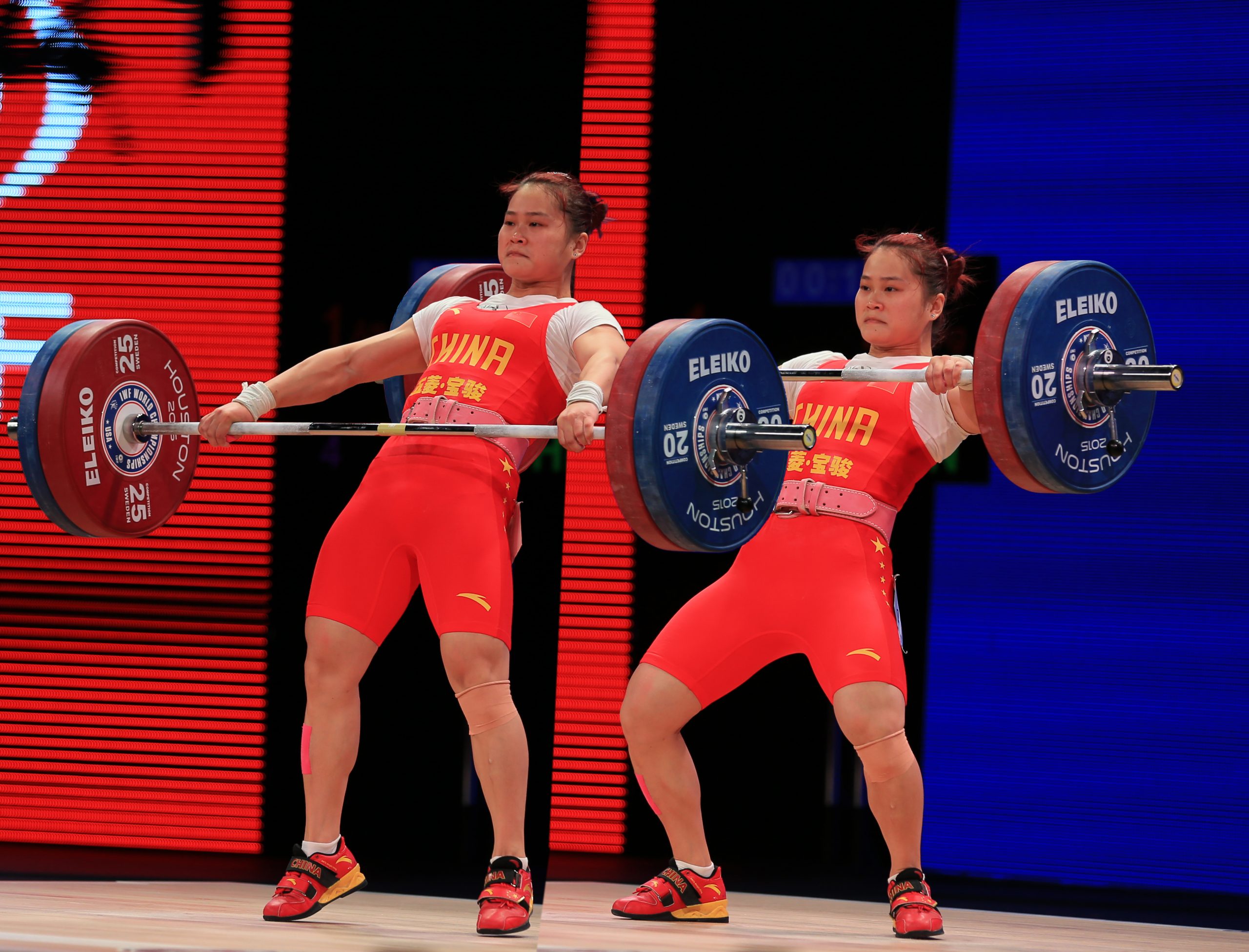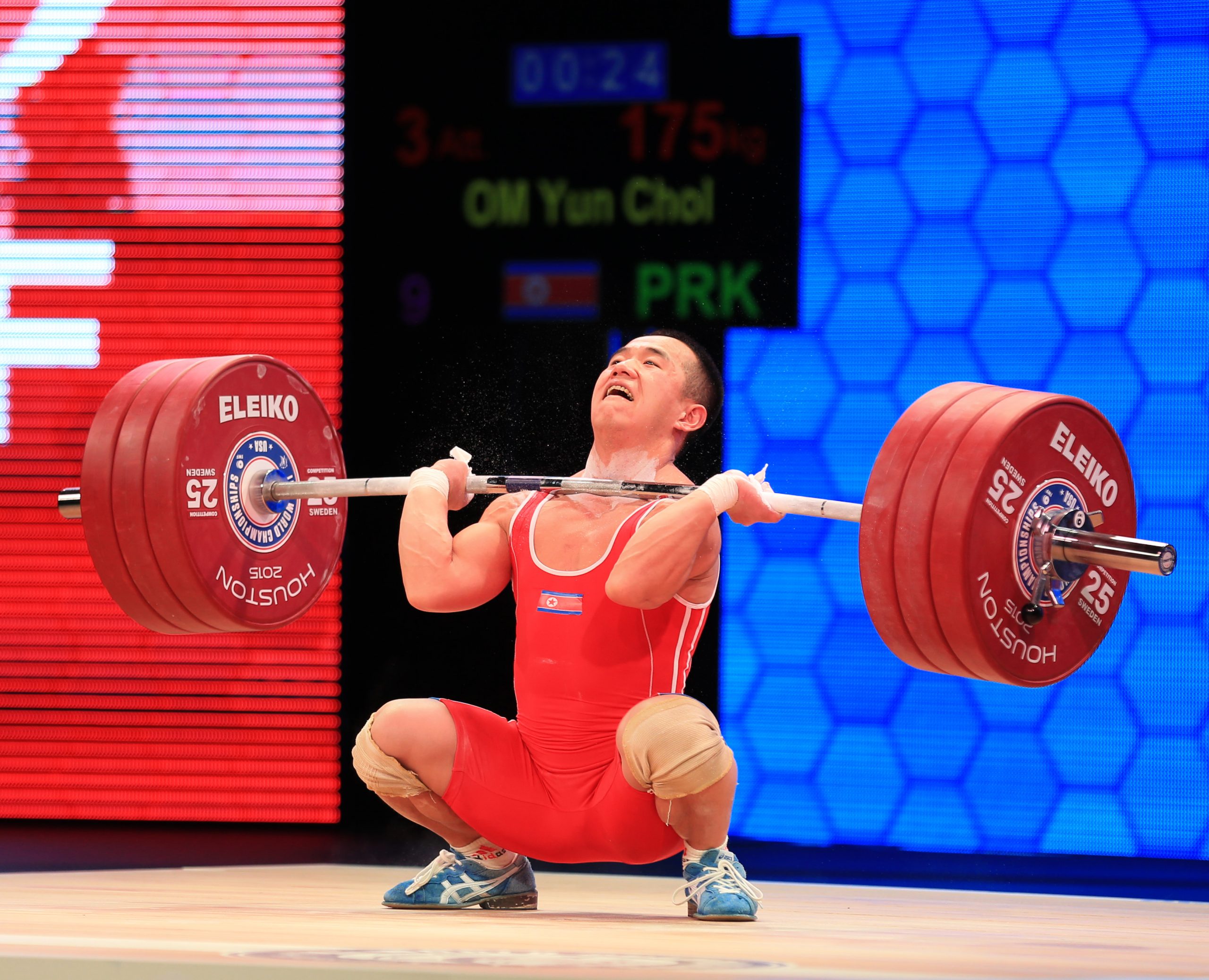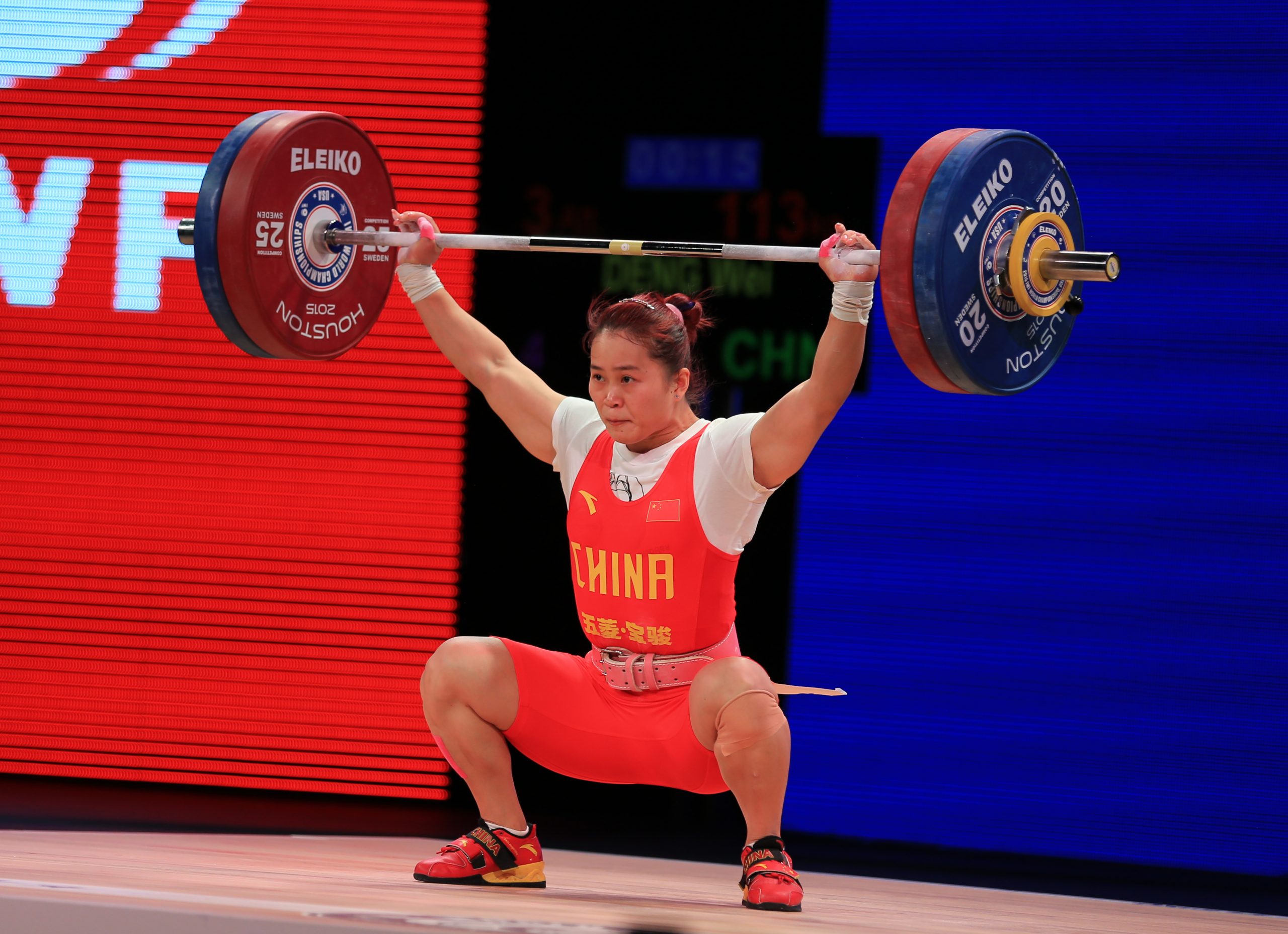Variations of the Jump Under the Barbell in the Snatch and the Clean
Andrew Charniga
SportivnyPress.com
“Research has shown that the longer the athlete’s feet are in the non – support position the faster the trunk descends.” Druzhinin, 1974
Figure 1. Variant 1. An optical illusion in weightlifting is manifest when an effective ‘jump down’ in weightlifting is frequently confused with a vertical jump. The athlete’s feet are rising from the floor – signalling a jump; but his pelvis is dropping. So, instead of jumping up and raising body center of mass the athlete ‘jumps’ down creating additional acceleration to lower it. Charniga photos.
Extensive research of weightlifting technique over a period of many years, confirms the importance of speed of movement. The speed with which the weightlifter drops under the barbell in the snatch, the clean, and the jerk; if timed and performed effectively will contribute to raising the barbell; as the athlete drops under the weight. The heavier the weight one attempts to lift, the lower the height to which it can be raised. Consequently, the heavier the weight, the slower its vertical speed, the faster one has to drop in order to fix the barbell at the chest or overhead in the snatch.
“the skill to execute the squat under in the presence of a slower barbell speed is also indicative of better technique; It is namely this skill that is important for lifting maximum weights.” I.P. Zhekov, 1976
Most weightlifting coaches would agree it is necessary to forcefully switch from lifting up with the arms and shoulder muscles to forcefully pulling the body down under the weight as fast as possible. Indeed, in his analysis of the clean technique of David Rigert, M. Shakirzyanov noted:
“For a period of 0.2 sec the athlete’s body could drop by 21 cm, but in actuality it descended 59 cm. All of this was due to the athlete’s forceful efforts after the explosion which did not stop in the non – support phase.”
Rigert’s body could only drop 21 cm in 0.2 seconds under the sole influence of gravity. The fact that he dropped 59 cm means his movement exceeded the 9.8 m/s² acceleration of gravity; which is impossible; unless Rigert was holding onto something and forcefully pulling himself down faster than the laws of physics permit. In this case, the slow moving barbell provided the support for the athlete to lower his body faster than a free falling object.
So, pulling oneself down with the muscles of the upper extremities is crucial to an effective descent. However, other elements are important. Namely, the athlete has to switch off the muscles which straighten the legs and switch on the muscles which flex the legs. This involves at least two components: relaxation of extensor muscles and recruitment of muscles to flex the legs and lower the pelvis.
Of the various strategies of dropping under the barbell the literature indicates the method; let’s call it variant 1; with significant flexing of the hips and raising the feet forcefully from the platform as depicted in figure 1 is the optimum. The forceful hip flexion adds to the athlete’s forceful efforts with the arms and shoulders. And, what sounds like a contradiction in terms, the athlete drops faster the longer feet are in the air.
Too numerous to mention sources in the weightlifting literature confirm the weightlifter jumps in the performance of the snatch and the clean. Consequently, many coaches have their lifters jump up to boxes, stacks of discs, perform standing long jumps and so forth to improve explosive strength for this element of weightlifting technique.
That being said, it should be emphasized there is no jumping up in weightlifting. Few stop to think that if a weightlifter endeavors to jump up at the end of the pull before dropping – first you have to come down to where you started before going lower.
Figure 2. Variant 2. World champion female lifter switches from straightening lower extremities to bending as her feet are moved to the side – without pulling (flexing) hips up. The action of jumping down is carried – out with a very slight raising the feet from the platform; with trunk tilting backward at a significant angle from the vertical. Charniga photos.
A vertical jump preceding the descent under the barbell precludes any semblance of mechanical efficiency to raise a maximum weight. On the other hand if the athlete endeavors to jump down when dropping under the barbell in the snatch, the clean and the jerk; technical proficiency is significantly enhanced.
The photos of the lifter dropping under a heavy snatch in figure 1 illustrate this concept very well. In the photo on the left the athlete’s navel is approximately level with the number 26 on the scoreboard in the back round. His legs are already beginning to bend. In the next photo the lifter’s feet are some 6 – 8 centimeters from the platform and he is flexing at the hip, the knee and raising his toes (dorsi-flexing), i.e., he is jumping. In point of fact, the athlete is jumping; just not up. He is jumping down. His pelvis has dropped significantly as his feet move up.
An effective jump down with the variant 1 method by forcefully flexing of hips, knees and ankles, imparts additional acceleration to the barbell; facilitating the lifter’s efforts to lower his body as he pulls his trunk down with his arms and shoulders. So, an optical illusion of vertical jumping is created. The feet are rising, but the trunk is dropping. Variant 1 illustrates Druzhinin’s (1974) obvious counter-intuitivity: the longer the athlete’s feet are in the air the faster the body drops. Furthermore, a connection was found between the length of time the feet are in the non – support and the depth of the squat (Druzhinin, 1974).
Consequently, all outcomes are positive with variant 1. The hips and knees flex, feet rise, the trunk is pulled down, the barbell goes up, the lifter drops low.
Figures 3 & 4: The world’s strongest man (record holder in the jerk with 305% of body weight) drops extremely fast under record attempt with feet raised high from the platform due to significant flexing of hips, knees and ankles. Charniga photos.
By most any measure the variant 1 technique would appear to be the most effective method for the weightlifter to lower into the squat. However, there is another element to what seems to be a simple action of assisting descent in the snatch by forcefully flexing the hips, knees, raising the feet and pulling the body down.
It cannot be possible to significantly exceed the acceleration of a free falling body as shown by Shakirzyanov’s analysis of Rigert’s clean; by merely pulling – pushing down and flexing lower extremities. In point of fact, the athlete must posses the ability for high speed switching from contracting muscles to relaxing; so, that unnecessary tension from muscle antagonists do not impede the speed of his movements.
So, a rapid descent under the barbell is not a jump up and and pull down; but, a jump down – pull – down, flexing of lower extremities facilitated by extremely fast relaxation of unnecessary muscle tension. However, variant 1 is not the only strategy of effectively jumping under the barbell in the snatch and the clean.
Another variant of jumping under the barbell, let’s call it variant 2; is to slide the feet to the side while rapidly flexing the lower extremities. One observes this method most often with female lifters. Super elites like DENG Wei in figure 2 and others who employ this method of jumping under the barbell, drop extremely fast and low without noticeably raising the feet from the platform; and, without forcefully flexing the hips.
These athletes are actively pulling the trunk down and flexing the lower extremities just as the lifters who pull the hips up and raise the feet. However, the muscle action of variant 2 is different different from that of variant 1.
“The two joint muscle gastrocnemius can flex knee and flex ankle simultaneously.” F.J. Zajac, 1993
Textbooks tell us the main muscles involved in flexing lower extremities are hip flexors such as iliacus, psoas, rectus femoris, sartoris and hamstrings. However, since rectus femoris, sartoris and three fourths of the hamstrings cross – two joints they cannot be classified as either flexor or extensor muscles, i.e, they have multiple functions.
Furthermore, a thigh muscle typically only considered to work at the ankle joint; the gastrocnemeus can flex knee and ankle simultaneously. When this muscle group acts to flex knee and ankle; of course this affects the hip. The muscles in the front of the shin the tibialis anterior pull the feet up which also affect knee and hip. In short, such an action as flexing lower extremities in dropping down under the barbell is far more complex than can be found by merely perusing university textbooks.
The main difference between the variants has to be variant 2 involves fast relaxation of muscles, i., e., a faster release from contraction to relaxation. Whereas, the significant effort expended in variant 1 can be considered partly the male athlete’s need to forcefully release tension switching from extensor muscles to flexing muscles of the lower extremities to lower the body quickly.
Figure 5. The extraordinary complexity of instantaneous switching directions from lifting up to dropping down in the snatch and the clean involves coordinating the rapid relaxation of muscles straightening lower extremities (extensors) and likewise a sequential rapid contraction – relaxation of arm and shoulder muscles when the lifter turns the bar over in the snatch i.e., switching the muscle tension of the lower extremities opposite to those of the upper. Charniga photo.
More effort is obviously involved in variant 1 because of the muscle actions are greater. Anecdotal evidence indicates males have more muscle tonus than females; but, little exists on gender differences in the ability to release muscle tension.
Anecdotal evidence points to a gender based muscle contraction – relaxation anomaly. Male weightlifters are able to generate higher velocity at barbell separation in the pull than female lifters; an indication of faster and greater recruitment of muscle fibers. Some have attributed the lower speeds achieved by the female lifter at the beginning of the pull to a slower electro – mechanical delay, i.e., the time it takes from a decision to contract muscles to the actual start of contraction.
” …executing the squat under the barbell after completing the pull in the snatch or the clean involves an instantaneous switching from the extensor muscles from a state of limit tension to a state of complete relaxation.” Y. Verkhoshansky, 1988
On the hand, very few males are able to effectively relax muscle tension after a difficult clean in order to re – group and prepare to jerk the barbell. Extremely few male weightlifters succeed in jerking the barbell under these conditions. Conversely, many female lifters are significantly better at releasing tension and re – grouping, before proceeding to jerk the barbell; despite a prolonged and draining struggle to stand from a squat.
Less effort would appear to be involved in performing variant 2 because there is obviously less aggressive muscle action required to flex lower extremities and lower the trunk. In all probability the super elite and elite females compensate for lower muscle mass and speed of muscle fiber recruitment with a natural ability to relax muscles to lessen resistance to movement; while, coupling this quality with more mobility in joints. The speed of descent under the barbell for these super elites and elites is the result of muscle effort pitted against less resistance of unnecessary muscle tension.
Complications for the female weightlifter jumping down with variant 2 related to Bernstein’s problem
“Coordination of movement is the process of mastering the redundant degrees of freedom of the moving organism.” (Bernstein, 1967)
Soviet era Biologist, father of motor learning, Nicolai Bernstein proposed one of the fundamental complications of animal and human movement. Stated simply Bernstein’s problem raises the question as to how animals and humans manage the large and even redundant degrees of freedom of movement potential of the body to move about efficiently and without injury.
Assume for a moment the observed gender differences in the ability to switch from contracting to rapidly relaxing muscles is in point fact instead of a logical assumption. And, this quality of rapid relaxation of muscles contributes to the ability to drop at high speed under a barbell. Problems establishing balance arise when this quality is coupled with a large amplitude of motion in the lower extremities. Consider the example of the super elite female sitting in extremely low squat in figure 6. The accompanying video of the same lift illustrates Bernstein’s problem of coupling high speed relaxation of muscles with a very large range of motion in the joints.
Figure 6. Super elite female sitting extremely low in squat with near world record weight. Charniga photo.
The lifter drops extremely fast in the video to a very low squat and experiences difficulty establishing balance and controlling the barbell in the subsequent recovery. The extremely fast jump under the barbell resulting from rapid relaxation of the muscles of the lower extremities, the lifter’s forceful efforts to pull her trunk down and the very large mobility of her hip, knee and ankle joints create the conditions where it is difficult for her to control all of this motion in joints and establish a stable equilibrium.
And, of course, these factors complicating Bernstein problem are further exacerbated by a too flexible female barbell. The lifter’s body weight, the weight of the barbell relative to her mass, her hand spacing (normal for her) her speed of movement, abruptness of hitting the low squat and the dimensions of the barbell cause further complications. Those factors all contribute to excessive oscillation of the barbell which is already visibly bowed in the low squat position of the photo.
Two distinct variants of jumping down under a barbell in the snatch and the clean are both highly effective means of performing this critical phase lifting a maximum weight. One observes variant 1 most often with male weightlifters where the male physiology comes with the advantage to generate large muscle tension faster than the female lifter. However, this advantage comes with the caveat; males are slower to release tension.
The caveat is reversed with variant 2, females experience difficulty rapidly generating significant muscle tension; attributed to a slower electro – mechanical delay. However, the female lifter is able to compensate at critical junctures in the weightlifting exercises with faster (than males) release of muscle tension.
Does a gender difference matter?
An interesting aside here is the question as to whether gender distinctions in muscle recruitment patterns of switching from forceful straightening to rapidly flexing of lower extremities would manifest in differences in injury rate between male and female weightlifters. The recruitment of muscles for variants 1 and 2 are obviously different.
There is no evidence to support such a distinction would make the female lifter more susceptible, to knee injury, for instance. On the contrary, evidence from medical commission of the European Weightlifting Federation over a span of seven years showed a low overall injury rate at European championships with no knee injuries recorded for female lifters.
However, in the USA anterior cruciate ligament (ACL) injury is practically the national disease of female athletes in such sports as basketball, volleyball, soccer, lacrosse and others. The literature endeavors to link the injuries to differences in female anatomy and physiology such as lax articulations, estrogen, smaller ligaments and gender differences in muscle activation of hamstring muscles to ‘support’ the ACL ligament.
The gender (although not all exclusive) distinctions of muscle recruitment of variant 1 and variant 2 presented here contradict the American ideas female differences in anatomical structure and physiology make them more susceptible to knee injury. This is especially telling considering the substantially greater forces inflicted on the joints and soft tissues of weightlifters in comparison with such activities as volleyball, basketball, soccer and so forth.
Conclusions
Two major variants (1 & 2) of jumping under the barbell in the snatch and the clean are similar, but with subtle distinctions.
The ‘action – reaction’, technique of forcefully pulling hips up and raising feet (variant 1) would appear to be the best strategy of jumping under the barbell in the snatch and the clean. The concerted action of flexing at hip, knee, ankle and pulling feet up, adds acceleration to downward shifting of the pelvis. These actions add vertical acceleration to the barbell. Furthermore, the longer the feet are in the air the faster the descent. So, all outcomes are positive. The feet rise from the platform the trunk drops fast, the barbell goes up.
Variant 2 is likewise and effective method of jumping under the barbell. This variant is most often observed in female lifters. The super elite and elite female deploy the features of female biomechanics and physiology to compensate for less muscle mass and speed of recruitment of muscle fibers, often referred to as electro – mechanical delay; with a faster relaxation of muscles. The outcome can be very fast descent coupled with a very low squat position.
References
1/ Druzhinin, V.A., “Teaching Snatch Technique to Beginners” Tiazhelaya Atletika 29- 31:1974 1974. Translated by Andrew Charniga, Jr.
2/ Zhekov, I. P., The Biomechanics of the Weightlifting Exercises, FIS, Moscow, 1976. Translated by Andrew Charniga, Jr.
3/ Shakirzyanov, M.S., “Technique Features of World Champion David Rigert”, Tiazhelaya Atletika 22- 26: 1974. Translated by Andrew Charniga, Jr.
4/ Vorobeyev, A., N., Weightlifting, textbook for the institutes of sport, FIS, Moscow, 1988
5/ Verkhoshansky, Y.V., Fundamentals of the Special Physical Preparation of Athletes, FIS, Moscow, 1988 Translated by Andrew Charniga, Jr.






